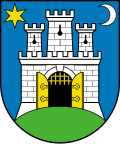2020 shooting
On morning of 12 October 2020, a 22-year-old Danijel Bezuk from Kutina came on St. Mark's Square with assault rifle (AK-74) and started shooting at the Croatian Police who were protecting the entrance of Banski Dvori, in his attempt to enter the Banski Dvori where Prime Minister of Croatia has his office. He wounded a police officer, a 33-year-old Oskar Fiuri, who was guarding the main entrance, wounding him with four rounds, after which he continued shooting on Banski dvori. Another police officer who was guarding the Parliament on the opposite side of the square noticed what was happening, so he took out his personal weapon and fired at the attacker. Bezuk ran to the nearby street to take cover and reloaded his gun. He then returned and fired on the police again, but was again suppressed by the police fire, and fled the scene in response. After the aftermath, Bezuk ran to Jabukovac street where he took his own life. [6]
In February 2021, Prime Minister Andrej Plenković stated that the motive of the attack was his party Croatian Democratic Union's (HDZ) coalition with the Independent Democratic Serb Party (SDSS). In the immediate aftermath of the shooting, President Zoran Milanović held a press conference in which he called the government to protect the central state institutions, saying that "they are not a tourist destination". Therefore, since October 2020, the St. Mark's Square remains closed for visitors, tourists and residents who live at nearby buildings. [7]
Until 2020 the square was also the site of the inaugurations of Croatia's presidents. Franjo Tuđman took his oath as President of the Republic in 1992 and 1997, Stjepan Mesić in 2000 and 2005, Ivo Josipović in 2010, and Kolinda Grabar-Kitarović in 2015. However, in 2020 Zoran Milanović decided to take his oath in the Presidential Palace instead.
2024 self-immolation incident
On Tuesday around 9:40 a.m. on 12 June 2024, on the south side of Zagreb's Mark's Square, a 57-year-old doused himself in gasoline and lit himself on fire. The male person who set himself on fire on was treated at the Traumatology Clinic of the KBC Sisters of Mercy in the intensive care unit where he later died of his injuries after 9 pm, according to the press release. Although the police did not announce his identity, it was found out that he was a 57-year-old man from Virje, who lived in Koprivnica, a pensioner, who previously worked at Croatian Railways Cargo. The motive is still unknown, and the St. Mark's square is still closed for public. [8]




